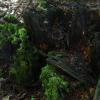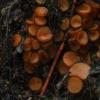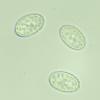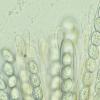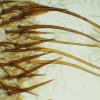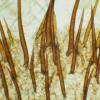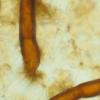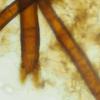
21-12-2025 09:32
Hello.A tiny ascomycete found embedded in wood in

22-12-2025 00:47
Patrice TANCHAUDBonsoir, récolte à proximité du milieu dunaire

21-12-2025 21:32
Pol DebaenstHello, Garden, Burgweg 19, Veurne, BelgiumOn 10/1

21-12-2025 21:40
Isabelle CharissouBonjour, j'aimerais connaitre les références de

21-12-2025 21:31
Pol DebaenstHello, Garden, Burgweg 19, Veurne, BelgiumOn 10/1

21-12-2025 21:31
Pol DebaenstHello, Garden, Burgweg 19, Veurne, BelgiumOn 10/1

20-12-2025 23:08
Patrice TANCHAUDBonsoir, récolte sur sol sablonneux dans l'arri�

20-12-2025 15:47
Mirek GrycHi.These grew on pine wood that was heavily covere
Scutellinia colensoi?
Juuso Äikäs,
31-07-2020 21:08
The hairs are max. 1350 µm long and 35 µm wide. Most of them are septate but there are some long, aseptate hairs as well.
The spores don't have a loosening perispore in heated CB, and the measurements are:
(16.5) 16.7 - 18.2 (18.4) × (10.7) 10.8 - 11.3 (11.8) µm
Q = (1.5) 1.51 - 1.65 (1.7) ; N = 15
Me = 17.4 × 11.1 µm ; Qe = 1.6.
Using Jeannerot's key I arrived at S. colensoi but am not entirely sure if this is the right species. Other opinions are welcome.
Viktorie Halasu,
31-07-2020 21:53

Re : Scutellinia colensoi?
Hello,
did you compare with S. vitreola too? The warts look more isolated and angular, than those colensoi-like ridges, also hairs are much too short for colensoi.
Best regards,
Viktorie
did you compare with S. vitreola too? The warts look more isolated and angular, than those colensoi-like ridges, also hairs are much too short for colensoi.
Best regards,
Viktorie
Juuso Äikäs,
31-07-2020 22:21
Re : Scutellinia colensoi?
Thanks for the opinion.
The spore size would fit S. vitreola and the ornamentation looks pretty good to me too, but according to the info I found, the hairs are too long for that species!
The spore size would fit S. vitreola and the ornamentation looks pretty good to me too, but according to the info I found, the hairs are too long for that species!
Viktorie Halasu,
01-08-2020 09:16

Re : Scutellinia colensoi?
Regarding the hair length:
* (340)370-570(640) um (original description in Kullman 1982, based on two collections)
* 225-975 um (Matocec et al 1995, based on five collections)
* 300-900(1100) um (Schumacher 1990, based on holotype and 9 norwegian colls.).
In my opinion, it's still the same kind (group) of hairs, 3-4-multifurcate base and length somewhere between 800-1200 um. Kullman wrote 1-2-3-many roots, that is ok, perhaps she just found a deviating specimen with shorter hairs. I've seen several half-mature collections of S. crinita with multifurcate and branched hair base, but hair length < 1000 um.
S. colensoi, pennsylvanica and partly S. trechispora are in another group, with hairs up to 2000 um (or sometimes exceeding).
I'm more concerned about the spore shape, vitreola should have Q like scutellata, i.e. around 1,7-1,8. Mato?ec et al wrote about "two types" of vitreola found by them, with narrower or broader spores respectively. Hopefully someone here has more experience with the species than me.
* (340)370-570(640) um (original description in Kullman 1982, based on two collections)
* 225-975 um (Matocec et al 1995, based on five collections)
* 300-900(1100) um (Schumacher 1990, based on holotype and 9 norwegian colls.).
In my opinion, it's still the same kind (group) of hairs, 3-4-multifurcate base and length somewhere between 800-1200 um. Kullman wrote 1-2-3-many roots, that is ok, perhaps she just found a deviating specimen with shorter hairs. I've seen several half-mature collections of S. crinita with multifurcate and branched hair base, but hair length < 1000 um.
S. colensoi, pennsylvanica and partly S. trechispora are in another group, with hairs up to 2000 um (or sometimes exceeding).
I'm more concerned about the spore shape, vitreola should have Q like scutellata, i.e. around 1,7-1,8. Mato?ec et al wrote about "two types" of vitreola found by them, with narrower or broader spores respectively. Hopefully someone here has more experience with the species than me.

